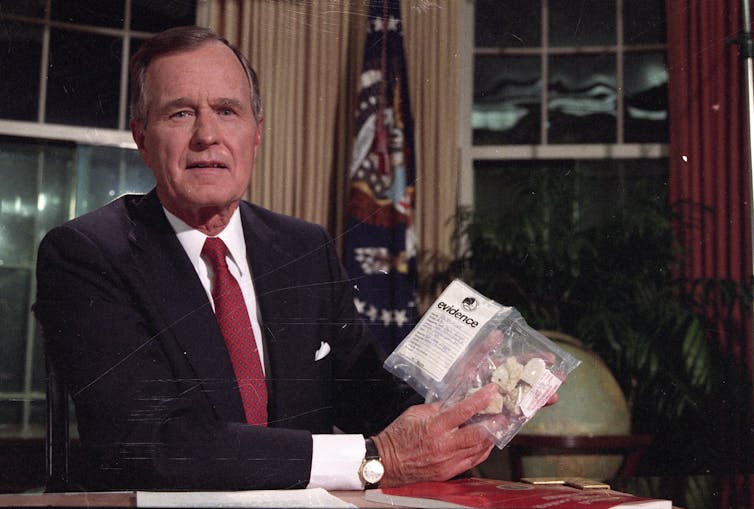On March 19, President Donald Trump unveiled his administration’s plan to stem the opioid overdose crisis in the United States, which has claimed some 350,000 lives since 2000. Among other measures, it proposes severe punishment for people involved in the illegal drug trade, including longer minimum jail sentences and potentially the death penalty.
This is an extreme version of what’s actually an old approach to combating substance use: Attacking the supply side of the drug trade.
From banning Chinese immigration in 1882 – supposedly on the grounds that Chinese people promoted vices like smoking opium – to the mass incarceration that followed the 1980s-era crack panic, the United States has long sought to reduce drug consumption by clamping down on drug sources. It has never killed citizens for trafficking drugs, though.
Worldwide, 33 countries have laws prescribing the death penalty for drug offenses, according to Harm Reduction International, a nonprofit group that advocates to end this practice.
Ample evidence shows that harshly punishing drug trafficking does not end drug consumption. Instead, my research suggests, it creates the spillover effect of criminalizing everyone associated with drugs – including drug users and, in particular, people from the most marginalized sectors of society.
Where is the death penalty used?
International human rights law mandates that the death penalty only be imposed for the “most serious crimes.” And many of the countries that allow capital punishment for drug crimes rarely apply this punishment in practice. A few – including Myanmar and Laos – never do.
Currently, seven countries regularly execute their citizens for drug offenses, according to Harm Reduction International: China, Indonesia, Iran, Saudi Arabia, Malaysia, Vietnam and Singapore.
Between January 2015 and December 2017, at least 1,320 people worldwide were executed after being convicted of drug-related offenses, many of them for nonviolent crimes like street dealing.
It’s noteworthy, I think, that all of these countries are either authoritarian regimes or democracies where civil liberties are seriously threatened. Among the 33 countries that punish drug offenses with death, only three – India, South Korea and Taiwan – are considered democratic by the watchdog group Freedom House.
China and Iran: High drug use despite death penalty
Typically, governments that kill their citizens for drug offenses don’t publish good statistics on drug use. That makes it difficult to document the effects of these policies.
Most of the information I use in this analysis comes from the United Nations Office on Drugs and Crime (UNODC) and from reports by international human rights organizations. Taken together, this data shows little correlation between harsh criminal sanctions and rates of drug use.
Iran has persistently high opioid consumption despite the government’s relentless persecution of drugs. In 2017, Iran accounted for 242 of 280 people executed worldwide based on death penalty laws for drug crimes.
Over 2 percent of Iranians report having used heroin or other opioids in the past year. That’s higher than the global average, which is just 0.73 percent.
In China, researchers from Amnesty International estimate that least 13 percent of all executions between 2011 and 2016 were related to drug offenses. Nonetheless, global statistics suggest that the country has one of the world’s largest population of injection drug users.
Singapore and Philippines: No evidence of progress
Singapore, which executed three people for drug offenses in 2017, claims that the death penalty has worked to reduce drug use. But this position is difficult to verify.
Government data there indicates that just 0.3 percent of Singaporeans have taken drugs in the past year – which is a low consumption rate. But the most recent available estimates also show that opioid use in Singapore is now rising. If the death penalty actually deterred drug use, consumption rates should have either decreased or remained steady.
Then there’s Philippines, home to the world’s deadliest war on drugs. Since Rodrigo Duterte became president in 2016, government forces have killed an estimated 12,000 Filipinos accused of using and selling drugs. Most of them were poor. None were given due process or allowed to defend themselves in court.
President Trump has praised Duterte, saying “he has done an unbelievable job on the drug trade.”
Little suggests that this bloody campaign is stemming drug consumption in the Philippines. In 2012, years before Duterte came to power, the country already had generally low rates of drug use, according to government data. And between 2008 and 2012, consumption of marijuana – the most widely used drug in the Philippines – decreased 17 percent.
These numbers call into question Duterte’s claim that “drug abuse” in the Philippines is a symptom of “virulent social disease.”
Minimum sentences and mass incarceration
Globally, more countries are introducing reforms to treat drug use as a public health problem rather than a criminal matter. At the 2016 United Nations General Assembly Special Session on Drugs, many nations voiced strong opposition to punishing drug crimes with execution.
The Trump administration has stipulated that the death penalty would only be used against “big drug pushers.” But, historically, United States drug laws have primarily punished the lowest-level people in the drug trade.
In 1986, the Reagan administration enacted mandatory minimum sentences for drug crimes. Under these laws, judges were required to give at least five years of jail time to people convicted of possessing just 5 grams of crack, for example – about 10 or 20 doses. By law, the judges could not account for mitigating factors such as addiction, mental health or poverty.

As a result, minimum sentencing guidelines have primarily swept up not violent kingpins but street dealers, mules, couriers and users who have occasionally sell drugs to maintain their own habit.
In 2016, 50 percent of federal inmates were drug offenders. Three-quarters of them were serving mandatory minimum sentences. Roughly half of those people had no or little criminal history prior to their drug convictions.
Mandatory minimums helped the U.S. prisoner population explode. Between 1986 and 2000, the number of people in jail almost quadrupled, though incarceration rates have somewhat slowed since the 2010 Fair Sentencing Act.
None of these policies led drug use in the United States to drop. Cocaine consumption, for example, decreased in the late 1980s, peaked in the 1990s and declined again starting in 2006. Meanwhile, heroin use has risen dramatically.
The real reasons for these trends remain under-researched but likely include demographic, social and economic factors, as well as changing perceptions of drugs.
Punitive drug policies have not helped countries deal with drugs. They’ve just created lasting social harms, both in the U.S. and worldwide.

